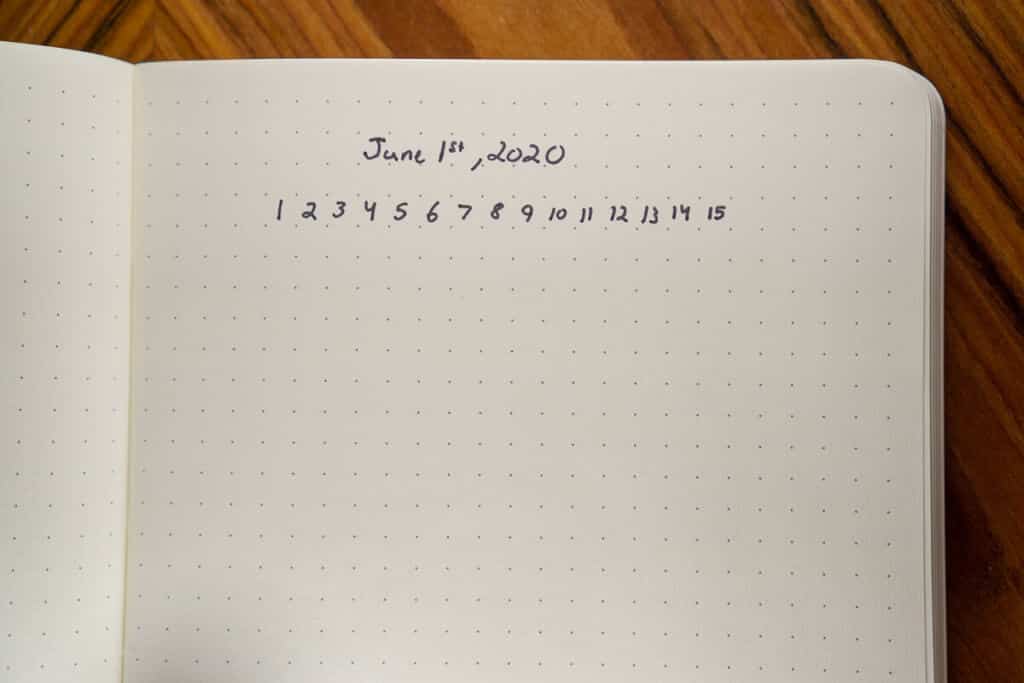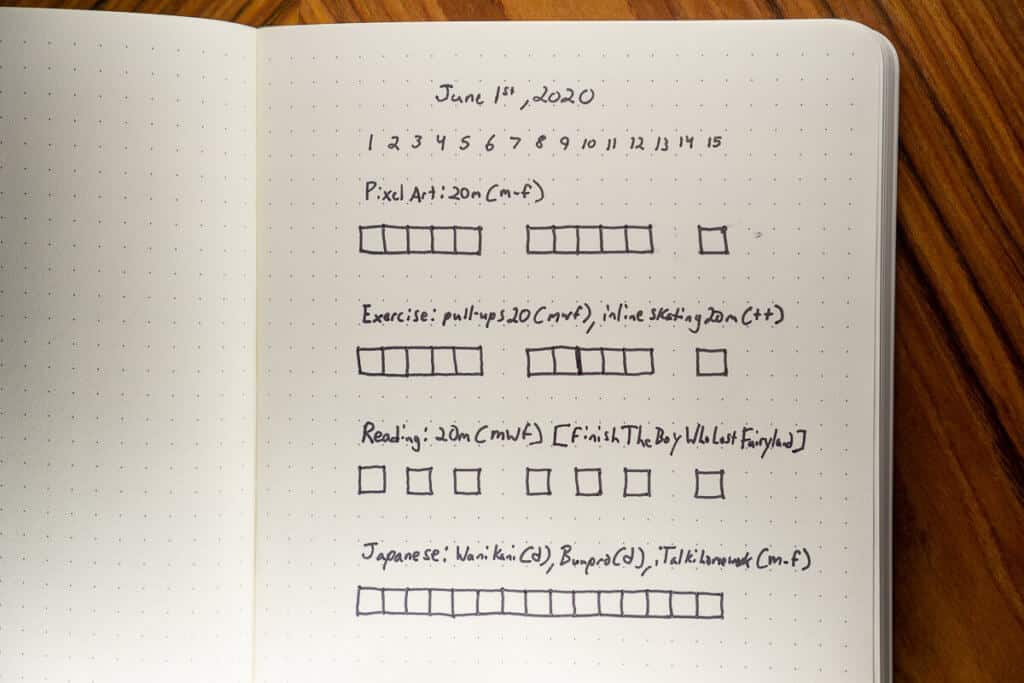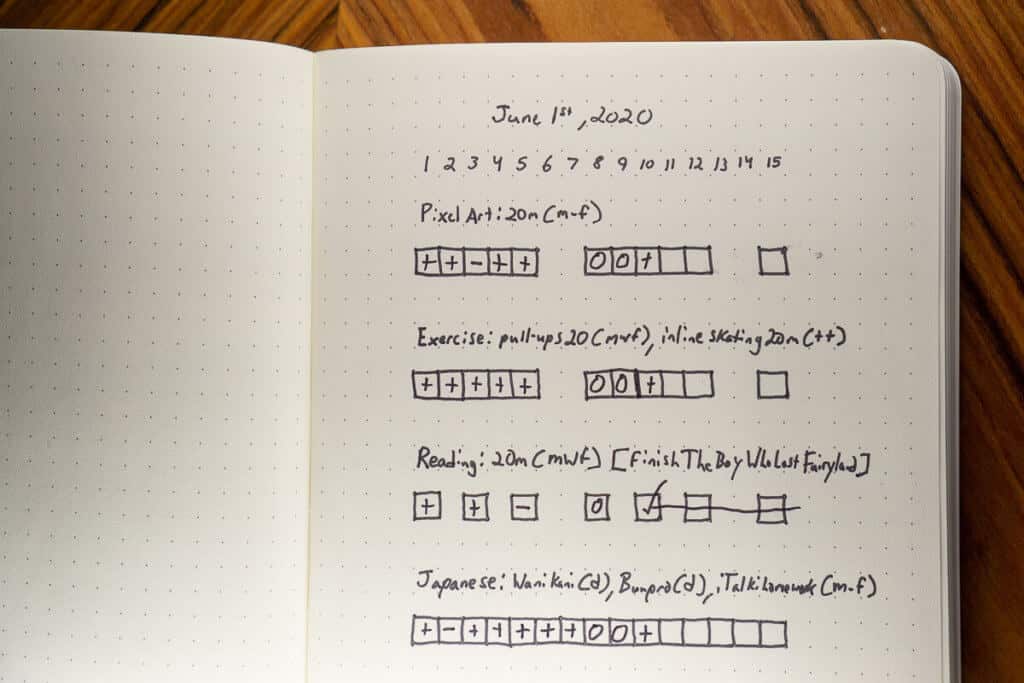Everyone has habits. You don’t need to like them, you don’t need to be aware of them, but you do have them, regardless. They’re the building blocks that form a large portion of what we do, because they have to be. Without an autopilot mode for us to rely on, we’d be mentally exhausted by the time we’d showered and gotten dressed in the morning.
With so many potential decisions to make every day, this autopilot mode is crucial. But it comes with an important feature: we get to program parts of our personal autopilot modes ourselves. By choosing how we set up the system, we’re choosing how our future selves will react automatically when they haven’t the time to consider what they’re doing.
The problem, then, is that building these habits is challenging and time-consuming. For some of you, the answer will be to use a habit-tracking app, but that is no longer the answer for me, it seems.
After going through many successful, yet short-term habit-tracking periods in my life, I had burned out on apps and wanted something a bit simpler. So back in October of 2018, I went out to a local bookstore and picked up a new notebook. Desperate for a fresh start, I came up with my own quick system for tracking habits, goals, failures, and the lessons I took from them.
What Does This System Do Differently?
I built this system to avoid some of the biggest pitfalls I ran into with traditional habit-tracking methods:
- Starting a new habit didn’t always have an obvious end-point, which kept me from wanting to try new things or push myself too hard.
- One failure breaks a streak forever, which meant that once I’d failed once or twice, I couldn’t feel successful anymore.
- I had no way of knowing which habits worked and which didn’t, as they were often deleted or spread out across several different apps from different attempts at getting reorganized.
- I couldn’t give enough attention to short-term goals that didn’t warrant a long-term habit to go with them.
- Even when I succeeded at my habit attempts, I grew bored of them. Without a clean slate feeling to re-energize and refocus my efforts, my successful habits became meaningless chores.
That last one ended up being the most important feeling I took into account when developing my new notebook-based system. I often craved a clean slate.
To find it, I tried to think about other times in life where I got to feel a fresh start at being the person I wanted to be. I came up with two: the start of a new year, and the start of a new semester at university.
I was always very excited to start a new semester and pick out my new classes. Some would be building toward long-term goals, like classes for my major or French, but some would be random exploratory classes, like an elective I took on mad science in popular media. I got to look in-depth at things like Batman, BioShock, and Metropolis, but without the ridiculous notion that I needed to commit to any of it long-term.
The ability to explore and move on from something had become hard to find as an adult. I needed it to stay excited and keep growing, but I just wasn’t finding it in normal habit-trackers, or at least the method in which many were designed to be used.
Finding a New System
Eventually, I came to a system based on a roughly two-week cycle: specifically, one that held precisely two cycles per month, starting on the first and sixteenth. These would be my semesters, and my goals would be my classes.
Synchronizing them with the calendar meant that I’d get the new year’s rush every first, and the midway point to refocus me—what did I want done by the end of the month? The second cycle would be a chance to re-adjust goal intensity and make the most of the remaining days before a new month arrived.
In addition to this, I created a way to track output-based goals that I could complete and be done with forever, and I kept an area for tracking setbacks.
Perhaps more importantly, I was also able to track when success at a habit didn’t result in anything useful—succeeding at checking boxes isn’t the overall goal of these things, after all. A successful habit brings value outside of just learning how to follow instructions.
Anyway, those are the basic points for what I refer to simply as my goalbook. Here’s how to set up your own:
Get a Notebook
Preferably, start with a dot-grid notebook. Others will work, but you may need to change how the markup works or draw a bit more to set it up.
Writing it out each time is part of the ritual, so embrace the annoyance of using a physical pen; it should feel a bit like you’re making your plans official. This is your ribbon-cutting ceremony for another shot at finding meaning.
If you’d rather track this digitally, we’ve created this helpful template, best experienced on a tablet. Just remember to keep track of where you put the old templates each year, so you can have a running log of how your trials have gone.
Write Out the Header
This could be something like “June 1st, 2020” or “June 16th, 2020”. I realize that the second cycle will contain a differing number of days, depending on the month. But I find that difference to be relatively unimportant compared to the psychological value of starting with a clean slate each month.
Two lines below, write out the days included in this cycle, one per box:

Choose Your Subjects
In line with the numbers written above, write out the subject of the habit, followed by the syllabus/schedule for this cycle.
The general format will be something like:
Subject: (action) (measurement, time or otherwise) (days of the week) [(outcome-based goal, if applicable)].
Here’s what this would look like in practice:
- Pixel art: 20m (D) (where D stands for daily)
- Exercise: Ring Fit Adventure one level (MWF), inline skating 20m (T Th)
- Reading: 20m (M-F) [finish The Girl Who Circumnavigated Fairyland in a Ship of Her Own Making]
- French: Duolingo 20m, Anki, watch one episode of Pokémon in French (M-F)
As a general rule, I try to stick to about 4 subjects per cycle. If I need to do more things for some reason, I try to keep to an absolute maximum of 6. Focusing on too many things at once is a recipe for failure, or worse, comfortable mediocrity.
I also try to have only a single outcome-based goal per cycle. In the example above, the outcome-based goal is to finish a book. If I have spare time throughout the cycle, I can put it toward reading even more than required, in an attempt to finish the goal by cycle’s end.
But beware of adding more than one output-based goal, as it becomes less clear where extra time should go, and you risk both goals.
If you have any other ideas, feel free to try them! The beauty of a paper system is that it’s completely flexible; the rules are yours to change as needed. The worst that could happen is that it doesn’t work and you learn from it for future cycles.
Fill Out Your Habit Schedule
A couple of lines below the description, fill in the borders of a box for each day you intend to work on this habit/goal.
This makes it easy to take a quick glance at your goalbook and see if you’ve finished everything for today. It’s also why I prefer a dot-grid notebook, as it has the measurements for squares, but no borders, allowing me to fill in my own more clearly.

Track Your Progress
This system has 4 basic symbols: +, -, O, and ✓
For progress, put a plus sign (+) in the box. It’s a plus sign, and not a checkmark, because you’re adding to your own ability to succeed. Progress, even without visible results, is worth feeling good about.
For a day you miss the requirements you’ve set out, put a minus sign (–). It’s a minus sign because this is a setback—you’re hurting your own ability to succeed. But, importantly, you haven’t failed. Pick yourself back up and get as many plus signs as you can going forward.
For a day with an excused absence of sorts, put a circle (O). This is for quick visual reference later on. The day I broke my finger on a mountain bike was a perfectly reasonable day not to prioritize my habits, and it’s a very different type of miss than deciding to binge-watch something all day. Life gets in the way sometimes, and we shouldn’t hold that against ourselves.
For outcome-based goals, if and when you finish the goal, use a checkmark (✓) instead of a plus sign for that day. Then, draw a line through the rest of the days. You’ve earned a break! Use the extra time for whatever you want.
If you’re feeling particularly motivated, you might draw up a new goal to work toward for the rest of the cycle, but I tend to just take the time to relax and build up the mental energy for the next one.

Track Your Setbacks and Other Findings
There are two more sections I haven’t talked about yet, and both happen on the left side of your notebook.
Each time you miss a day, including for excusable reasons, write down the date on the upper half of the left page, followed by the reason you didn’t get everything done.
This will help you see patterns of behavior that you might want to work on for later. Going back, a lot of my misses are due to not sleeping enough, so it’s an obvious thing I could work on that would help me.
The bottom half of the left page is reserved for general notes on how you’re feeling about your progress. Are your habits working as intended? Did you plan too much, or too little? Is something you thought would be useful not worth keeping up next time?
Tracking setbacks and thoughts throughout the cycle allows you to learn and grow faster, ready to start up next time with some fresh ideas.

Some Bonus Habit and Goal Formats
The basics of a habit or goal in this system are pretty straight-forward, but what about goals that don’t fit very well into a “do activity for time every day of week” format?
I’ve run into this a few times, so here are a few alternatives I’ve come up with. Note that this system is flexible, and you are absolutely free to try whatever you think will work. I can’t even predict all of my own future needs or desires, let alone yours.
Building habits isn’t just about discipline; there are real-world steps you can take to set yourself up for success! In this course, you'll learn how to set realistic goals, handle failure without giving up, and get going on the habits you want in your life.
Bonus Habits
For these, I’m just trying to casually track how often I do something naturally. I’ve used it most often to note when I go out to take photos somewhere.
All that’s required is to not include any required days, and not fill out any squares. Simply put a plus sign in any days you meet the minimum requirements you set, and leave the borders blank.
This shows you found and dedicated time to this task, even without harsh requirements. If you do really well with something like this, you may not even need to include it in the goalbook system next time.
Number-Tracking Habits
During a cycle or two, I wanted to keep better track of how much money I spent on voluntary things (that is, anything I chose to buy myself, rather than bills and such).
Each evening, I would total up how much I spent on things, round it to a full dollar amount, and put that number in the box for that day. If I did it again now, I’d probably use two lines: the top line for the amount spent that day, and the bottom to keep a running total.
You could use a very similar format if you wanted to do something a certain number of times. For instance, if I had a goal to take 40 photos this cycle, I could use the two lines to track how many new photos I took and the total I’d taken so far. Then, I could put a checkmark over or next to the final total when I was done.
If you happen to have minimum required days for a goal like this, I’d put a minus sign in required days where you didn’t add anything new.
But if you don’t have any specific schedule, I wouldn’t use a minus sign here. Not all goals are meant to be worked on daily, so seeing minuses where you didn’t do anything wrong would probably just demotivate you in the long run.

What Will You Do With Your Clean Slate?
That’s pretty much it. This system isn’t too complex once you’re used to it, and I’ve been using it ever since I started—the longest I’ve ever stuck to a single habit-tracking system.
Something about the feeling of starting over always helps me brush off the weight of past disappointments. With this system, I only need to wait a couple weeks to try out a brand new me.
You probably can’t do the same thing every day for the rest of your life, but that doesn’t mean it can’t help you for the next two weeks.
Want to build good study habits? Here’s how.



